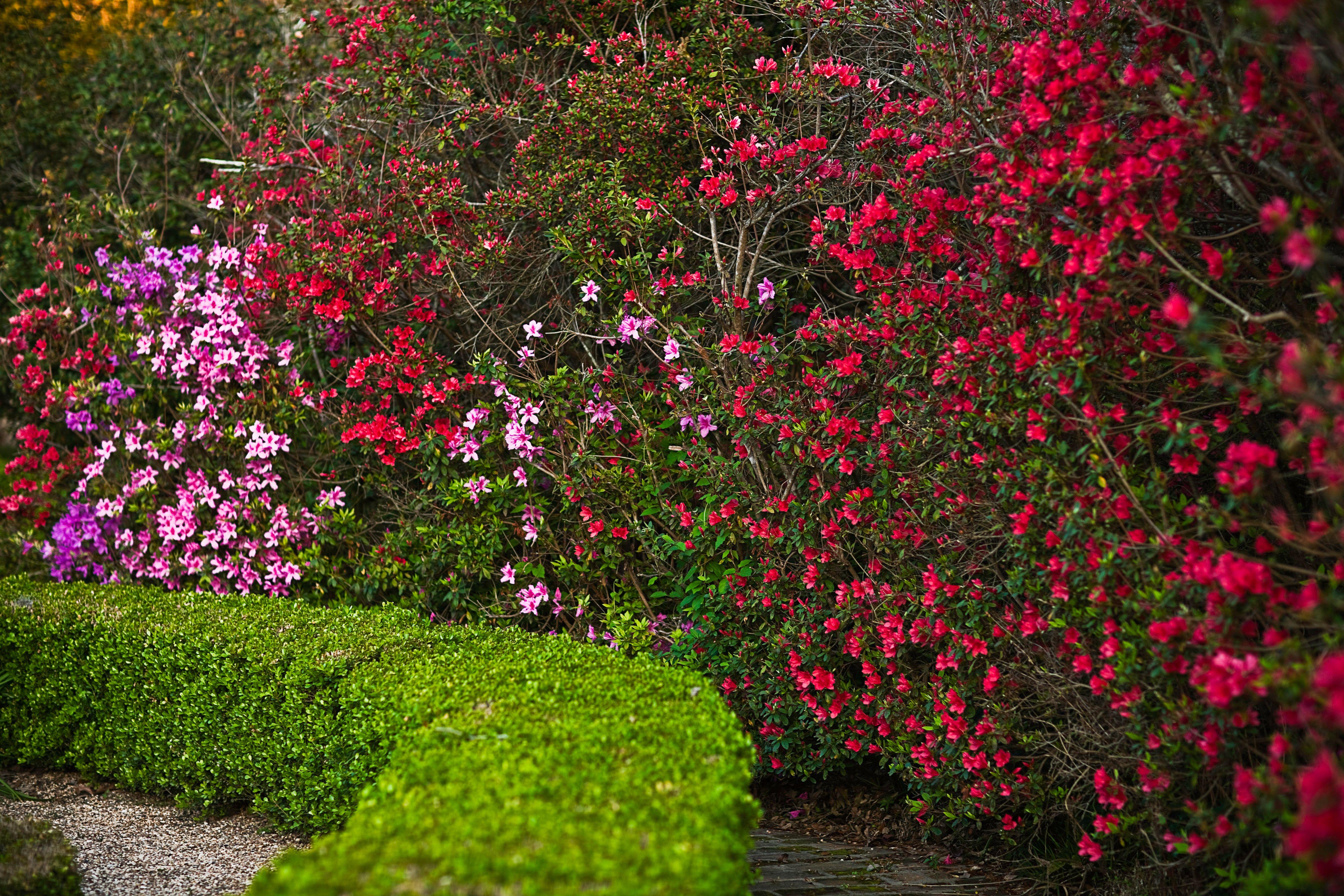Azaleas deserve a special place in gardens where these flowering shrubs can best catch the eye in spring. Some azaleas are repeat bloomers, adding splashes of color later in the growing season, and the leaves of some, especially deciduous azaleas, display beautiful fall colors. Thanks to their versatility, azaleas can be used in many different ways in both small backyards and larger spaces. Here are some ideas for landscaping with azaleas to best showcase their multi-season beauty.
What are Azaleas?
Azaleas are woody shrubs from the same genus as rhododendrons. In effect, all azaleas are rhododendrons, but not all rhododendrons are azaleas. Botanically speaking, azaleas usually have 5 stamens, rhododendrons often have 10 or more. While most rhododendrons are broadleaf evergreens, azaleas are evergreen or deciduous. Also, rhododendrons tend to be larger than azaleas and have larger flowers and larger, thicker leaves.
Azalea Growing Conditions
Both azaleas and rhododendrons do best in evenly moist, well-drained, acidic soil with a pH between 4.5 and 6. The soil should contain plenty of organic matter to allow the fine roots of these plants to penetrate the soil. To keep the soil moist and cool, a mulch of pine bark or pine straw is helpful.
Azaleas are more sun-tolerant than rhododendrons; however, they should be planted in a location where they are protected from the hot afternoon sun. While some shade is welcome, heavy shade will negatively impact flowering.
Related
Choosing Azaleas
There are numerous species and cultivars of azaleas offering a range of heights, shapes, and flower colors. To line a garden path or frame a border, select dwarf azaleas and low-growing azaleas. Medium-sized azaleas make fine foundation plants, offering a bit more pizzazz in spring than the usual yew or boxwood.
Plant breeders have also been working on improvements, such as azaleas that rebloom later in the season, such as Encore or Bloom-A-Thon azaleas. Some azaleas have variegated foliage, others offer fall color, or greater winter hardiness.
The American Rhododendron Society has a searchable database to help make selecting an azalea easier. Search criteria can be narrowed down to hardiness, height, bloom time, flower color, and other parameters.
Azalea Uses in the Landscape
Azaleas are beloved for the bountiful, bright color they offer in spring. They are also very versatile, lending themselves to many different landscape uses. Here are some you might try:
1. As a hedge plant. An azalea hedge is where a gardener’s preferred style comes into play: should it be sheared or unsheared? Both look good. The shrub’s natural shape is appealing on its own or paired with companion plants. But since azaleas tolerate heavy pruning and respond by sending out new shoots all along remaining stems, the shrubs work well when sheared into a formal hedge.
2. Windbreak embellishment. On their own, azaleas are not suitable as a windbreak because they require some wind protection. Instead, position them on the lee side of a windbreak (the side away from the prevailing wind direction) to dress up the plants serving as a windbreak.
3. In drifts. There’s strength in numbers, particularly when it comes to smaller azaleas. Increase their visual impact by planting multiple specimens in a drift or ribbon. For a longer show, plant early-, midseason-, and late-blooming azaleas. Consider adding bedding annuals to carry the color through summer.
4. Island bed component. Azaleas make fine additions to island beds. They are a focal point when in bloom, and an attractive foliage backdrop the rest of the year. For greater emphasis, use multiple azaleas but stick with one color. Add more variety with shade-loving companion shrubs such as pieris, daphne, and camellia.
5. Formal garden statement plant. Surround one large azalea or multiple small azaleas with a shorter hedge of boxwood, holly, or yew. Add in geometric shapes such as conical dwarf Alberta spruce and topiary junipers to further elevate your formal design.
6. Focal point. Pair a large azalea with a flowering tree such as dogwood, crape myrtle, redbud, or serviceberry. Underplant the grouping with a colorful carpet of groundcovers.
7. Mass plantings. Fill a bed or an area of your yard solely with azaleas. Use two different but complementary flower colors, such as red and pink, to play off of each other. Pair a deciduous azalea with an evergreen variety for a layered look. The evergreen foliage will help mask the bare stems of the azalea when dormant.
8. Woodland garden. Recreate a forest setting by planting azaleas among trees, tree stumps and branches, leaves, pine cones, and other items found in a forest. Add in some ferns, mayapples, and spring ephemerals like bloodroot, red trillium, trout lily, and Virginia bluebells for early season interest.
9. Garden room dividers. Plant rows of azaleas to separate one area from another to create individual garden rooms. For a multi-layer design, back up azaleas with yews, then stair-step down to shorter hostas and brunnera, and finish with a colorful groundcover.
10. Containers. Planting small or dwarf azaleas in containers makes sense both aesthetically and horticulturally. Aesthetically, raising up the azalea gives it greater emphasis and makes use of non-gardening space, such as a shaded deck or covered porch. Horticulturally, growing azaleas in a container with rich acidic soil offers a workaround for yards with unsuitable alkaline soil. Because azaleas have shallow roots, the container should be at least 2 feet in diameter and have large drainage holes.
11. Hanging baskets. Some azaleas lend themselves to growing in hanging baskets, including Belgian and Satsuki hybrids such as ‘Flame Creeper’ and ‘Pink Cascade’, which have a naturally pendulous habit. It is key to keep them well watered because hanging baskets dry out quickly.
12. Nonstop appeal. Regardless of the type of azalea you choose, plan for succession by adding companion plants that complement azaleas or bloom before or after azaleas. Foliage plants such as Japanese painted fern, hosta, caladium, and heuchera boast a long season of interest. For more color, add in spring bulbs such as daffodils, tulips, and hyacinths.



